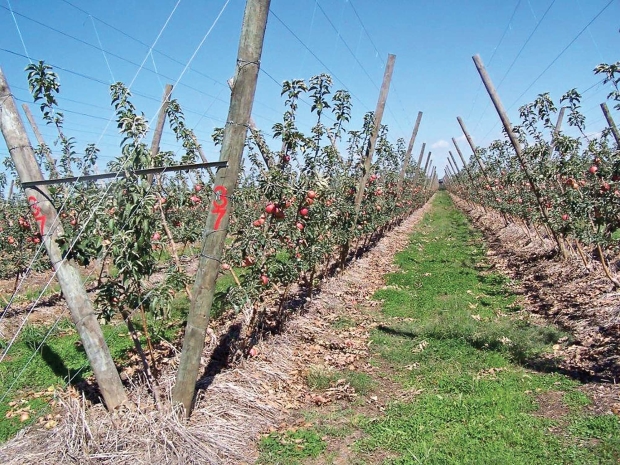
The soil was prepared one year before trees were planted. Ryegrass was sown on the hills and killed before these Pink Lady trees were planted. Gypsum every 2 or 3 years along with the weed mulch will keep the surface soil soft, permeable, and well aerated. Courtesy of Bas van den Ende
A research report by Judy Tisdall, soil scientist at La Trobe University, Melbourne, and Bas van den Ende, a tree fruit consultant in Australia’s Goulburn Valley.
For high yields of fruit of good quality, you need to fill the surface soil with feeder roots of your trees. To do this, the surface soil needs to be deepened and mulched so it is cool in summer, is stable, soft, and permeable, and stores enough water and nutrients for the roots yet is well drained so that oxygen can move to the roots and toxic gases are removed.
A good example are the red duplex soils in Northern Victoria, Australia, which consist of shallow loams 100-150 mm (4 to 6 inches) deep that overlie dense, hard, poorly drained clays. When we hill-up the surface soil before we plant the trees and use weeds to add organic matter to the soil, we deepen the surface soil available for feeder roots.
However, unless we continue to manage our surface soil carefully, we will eventually be back where we started. The surface soil will slump when quickly wetted by rain or irrigation and will set hard and dense when dry. Such hard, dense soils are hostile to feeder roots. Water from rain and irrigation will run off the bare surface into the inter-row and be lost as evaporation and surface drainage, taking soil with it. That is, hilled-up soil under the trees will be eroded.
In previous articles, we suggested that you use winter weeds, especially grasses, to mulch the soil in the tree row in summer. (See “Use winter weeds to improve soil” in the December 2014 issue and “Understanding soil organic matter” in the March 15 issue.) The mulch protects the soil from heavy rain, softens and cools the surface soil, adds organic matter, and improves the soil structure in the tree row.
In this article, we are suggesting how you can keep the mulched surface soil soft, permeable, and well-aerated and continue to encourage feeder roots to fill the surface soil.
Your mulch of dead winter weeds should not add more organic matter than is needed to stabilize the soil, otherwise you will end up where you started, i.e., with hard soil and few feeder roots. Under thick mulch, the soil remains wet for long periods after you have killed the weeds in spring. The soil remains stable, permeable, and well-aerated, with plenty of large pores, but the wet soil coalesces. That is, stable aggregates merge so that the soil hardens and restricts feeder roots.
To avoid this, add 2 to 3 tons of gypsum per hectare (0.8 to 1.2 tons per acre) every two or three years along with the weed mulch. Gypsum is calcium sulfate and works in two ways to prevent coalescence. Some calcium cations in the gypsum replace harmful exchangeable sodium and magnesium cations that are attached to the clay, and some of the calcium stays as soluble cations in the soil solution. This enables the clay particles (less than 2 microns in diameter) to coagulate, i.e., join together into small aggregates, but the soil will not coalesce. Gypsum is moderately soluble, so it eventually moves down the profile and out of the root zone and therefore needs to be replaced every few years. Another big advantage of gypsum is that it strengthens the bonds between the organic molecules and the clay, increasing the stabilizing effect of the organic matter.
Your aim with high-density plantings on trellises is to start producing high yields per hectare when the trees are young. Your trees’ feeder roots are dense and confined to small volumes of soil near the drippers or mini-sprinklers. It is crucial that enough soil is soft, stable, and well-drained to enable not only rain or irrigation water but also oxygen to reach all the feeder roots and for toxic gases to be removed. Ultimately, the depth of soil suitable for roots greatly affects the performance of fruit trees.
Following our strategy for soil management for orchards should help to:
—remove limitations of hard-setting soils to feeder roots.
—increase coagulation of clay particles and stabilize aggregates to form deeper soft soil.
—avoid wasting water, which increases water-use efficiency.
—keep the soil well-drained and well-aerated. •






Leave A Comment